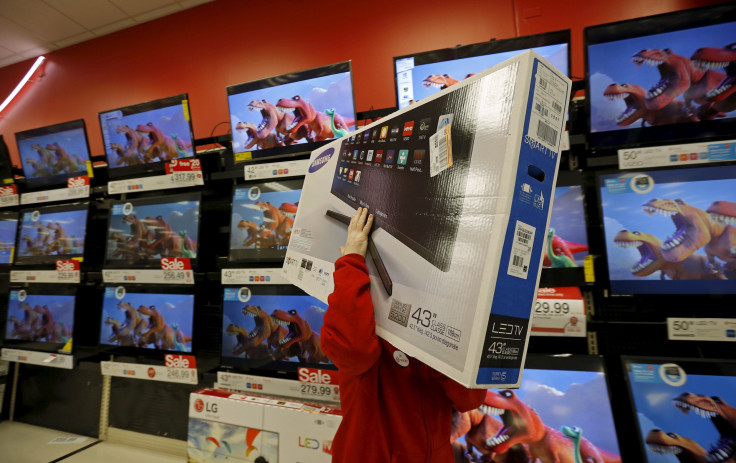Rising Income A Bright Spot For The Economy As Manufacturing Struggles

The outlook for the economy remains encouraging, with data released Wednesday showing consumer sentiment at a five-month high in December. Personal income rose for an eighth straight month in November, which should support consumer spending and economic growth in the fourth quarter and in early 2016.
U.S. consumer spending rose by 0.3 percent last month, according to data that was inadvertently released 12 hours ahead of schedule on Tuesday, while personal income rose for the eighth straight month on solid wage gains.
"The gain in income should prove a tailwind to fourth-quarter GDP growth as consumption remains the most prominent driver of domestic growth activity," said Gennadiy Goldberg, an economist at TD Securities in New York.
The National Retail Federation predicts holiday spending in November and December will be up 3.7 percent to $630.5 billion this year. That’s slower than the 4.1 percent growth during the same period last year, but significantly higher than the 10-year average of 2.5 percent.
However, an unusually warm December is weighing on sales of winter apparel, with cold-weather gear sales across the mid-Atlantic region down by more than twice the national average, according to the Wall Street Journal.
“There’s no question, we’ve seen much warmer weather and much lower sales. That’s pretty clear,” Greg Thomsen, managing director of the American branch of Adidas Outdoor, told the Journal.
In the business sector, a report Wednesday showed a gauge of U.S. business investment plans fell in November and the prior month's increase was revised sharply lower as the drag on manufacturing from a strong dollar and spending cuts in the energy sector showed little sign of abating.
The Commerce Department said non-defense capital goods orders excluding aircraft, a closely watched proxy for business spending plans, dropped 0.4 percent last month. October's increase in orders for these so-called core capital goods was revised down to 0.6 percent from 1.3 percent.
Manufacturing, which accounts for 12 percent of the economy, has also been hit by efforts by businesses to reduce an inventory bloat and sluggish global demand, which has curtailed new-orders growth.
The dollar has gained almost 20 percent against the currencies of the United States' main trading partners over the past 18 months.
Plunging crude oil prices, which on Monday plumbed their lowest levels since 2004, have put pressure on oilfield services firms like Schlumberger and Halliburton, forcing them to slash capital spending budgets.
A survey early this month showed manufacturing contracted in November for the first time in three years. Economists polled by Reuters had forecast core capital goods orders dipping 0.1 percent last month.
Core capital goods shipments fell 0.5 percent last month after October's downwardly revised 1.0 percent drop.
Shipments of these goods are used to calculate equipment spending in the government's gross domestic product measurement. They were previously reported to have declined 0.5 percent in October.
"Unless we see a big rebound in December or upward revisions, it appears that investment in equipment contracted in the fourth quarter," said Paul Ashworth, chief U.S. economist at Capital Economics in Toronto.
Rising Wages
A tightening labor market, marked by an unemployment rate that is in a range some Federal Reserve officials consider consistent with full employment, is starting to lift wages.
That in turn could gradually push inflation toward the Fed's 2 percent target and enable it to further raise interest rates next year. The U.S. central bank hiked its benchmark overnight interest rate last week by 25 basis points to between 0.25 percent and 0.50 percent, the first increase since mid-2006.
Last month, a price index for consumer spending was unchanged after nudging up 0.1 percent in October. In the 12 months through November, the personal consumption expenditures (PCE) price index was up 0.4 percent, the largest increase since December, after rising 0.2 percent in October.
Excluding food and energy, prices nudged up 0.1 percent after being unchanged in October. The so-called core PCE price index rose 1.3 percent in the 12 months through November, for the 11th straight month.
The Commerce Department's Bureau of Economic Analysis inadvertently released part of the consumption portion of its report late on Tuesday. It showed consumer spending increased 0.3 percent last month after being unchanged in October.
Consumer spending, which accounts for more than two-thirds of U.S. economic activity, rose 0.3 percent when adjusted for inflation after holding steady in October.
A third report on Wednesday showed the University of Michigan's consumer sentiment index increased to 92.6 this month, the highest reading since July, from 91.3 in November. Low inflation, which is boosting household purchasing power, accounted for the rise in sentiment this month.
--Reuters contributed to this report.
© Copyright IBTimes 2024. All rights reserved.











